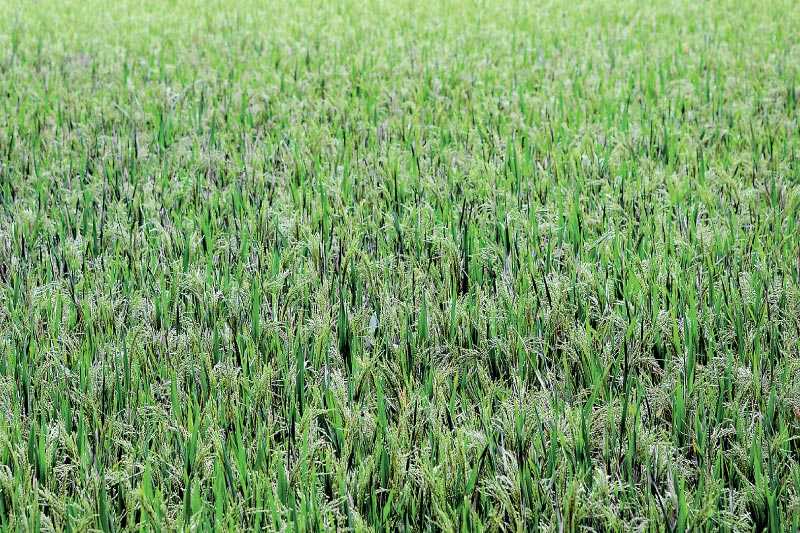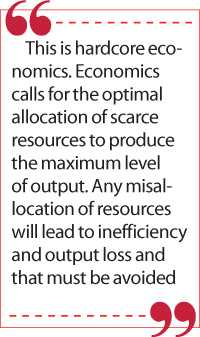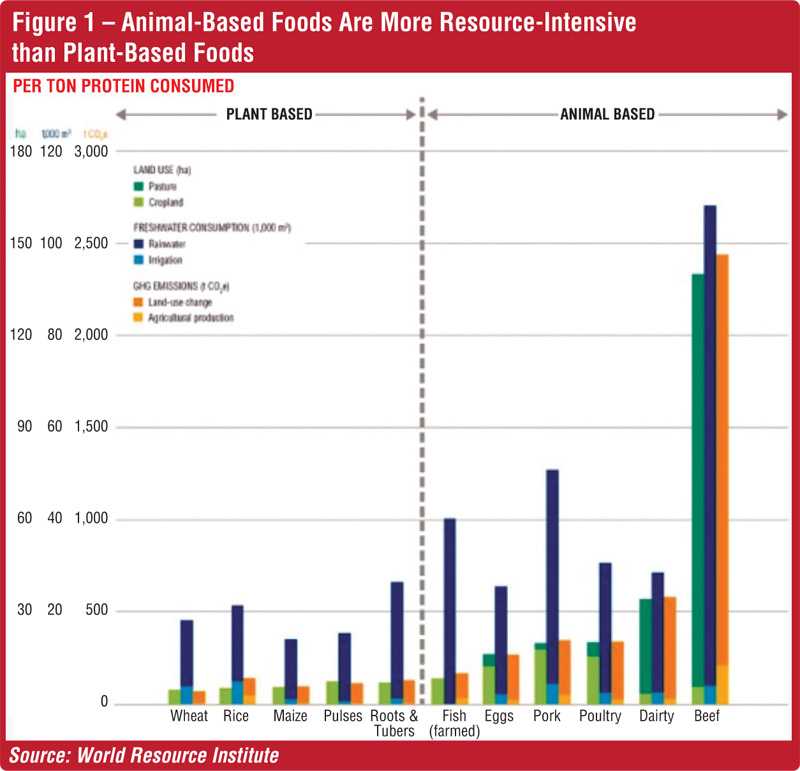Tuesday Mar 04, 2025
Tuesday Mar 04, 2025
Monday, 3 May 2021 00:30 - - {{hitsCtrl.values.hits}}

Though some selected countries would be able to feed their people through improved agricultural production, in the entire globe, it is a matter of concern to feed the rising number of mouths. Unless a system is found to produce more with less, the global community faces a high risk of starvation – Pic by Shehan Gunasekara
 Agriculture should aim at producing more with less
Agriculture should aim at producing more with less
There is good news for vegans. The news has been revealed by scientific discoveries and validated by hardcore economics.
A team of researchers from Canada, Australia, India, and the UK have authored a joint paper arguing that animal proteins are more resource-using compared to plant proteins. Hence, they recommend that the latter should be promoted through continued research in biotechnology. The paper has been published online on 20 April in Science Direct and is available at https://www.sciencedirect.com/science/article/pii/S1360138521000637.
The six scientists involved in this exercise have been Sven Anders of the University of Alberta, Canada, Wallace Cowling and Aswani Pareek of the University of Western Australia, Kapuganti Jugadis Gupta and Sneh L Singla-Pareek from different research institutes in India, and Christine H. Foyer of the University of Birmingham, UK.
According to the authors, there are two scientific revelations relating to agriculture. One is that agriculture contributes a significant portion to climate change in the form of the emission of greenhouse gases. The three offensive gases in the form of carbon dioxide, methane and nitrous oxide arising from agricultural activities have been responsible for about 23% of the total global emissions. The other revelation is that the two main resources used in agriculture – land and water – are in short supply threatening the global food security in the future. Therefore, there is a necessity for using these resources efficiently to achieve the highest level of productivity.
This is hardcore economics. Economics calls for the optimal allocation of scarce resources to produce the maximum level of output. Any misallocation of resources will lead to inefficiency and output loss and that must be avoided.
Animal-based foods are more resource-intensive compared to plant-based crops
As between plant-based foods and animal-based foods, science has revealed that animal-based foods use more resources, both land and water, than plant-based foods. Thus, to make agriculture more environmentally-friendly and use resources efficiently, it is the plant-based foods that must be promoted. To do so, an essential requirement has been the use of biotechnology, the art and science of using biological processes for use in industry, agriculture, or services. It specifically helps agriculture by genetically modifying microorganisms, plant cells, and genes relating to livestock breeding.
Land and water and impact on climate change should be deciding factors
People need proteins as a part of a balanced diet. However, in terms of the basic principles of economics, the production of proteins should be done by using the available resources efficiently, that is, getting the maximum output by employing the least quantity of resources. There are three factors that should be considered, according to authors, when assessing the efficiency of the use of resources for producing proteins. They are land, and water which are natural endowments and the minimum amount of the emission of greenhouse gases to environment which comes from conscious policymaking and a must for avoiding the disastrous climate change.
When comparing the main sources of proteins – plants and animals – the source that uses the least extent of land, and the quantity of water and causes the least emission of greenhouse gases would be ranked as the more efficient source of proteins. Since land and water are limited in supply and climate change would destroy everything which mankind has so far gained, the global community should choose the available options carefully to ensure sustainable food security.
 Conserve water and land
Conserve water and land
At present, the animal-based foods provide about 37% of the global needs of proteins. However, they are resource-guzzlers because they use a little over 75% of agricultural land and a significant quantity of water for producing the same. Worse, they also account for about 67% of the greenhouse gases emitted through agricultural activities. Comparatively, all plant-based proteins use less land, and water and emit less greenhouse gases to environment. These comparative numbers are presented in graphical form in Figure 1 based on the data compiled by the Washington DC based World Resource Institute and reproduced by the authors in their paper under reference.
The Figure under reference has measured the resource use in terms of the extent of hectare and 1,000 cubic meters of water used for producing a tonne of protein and the volume of greenhouse gases emitted during the process of production. While all the animal-based protein suppliers are ranked very poorly by all the three criteria compared to plant-based proteins, beef has been specifically very bad supplier of proteins. This is intuitively understandable because they need larger pasture lands and more water.
In addition, the regurgitation process which the cattle use for digesting foods causes the discharge of a high volume of methane to atmosphere. This regurgitation process involves taking back half-digested foods from the first stomach to mouth and then chewing and swallowing into the second stomach.
Challenge of feeding the rising mouths of the globe
Given these resource limitations, assuring food security for a rising population becomes a challenging task for the global community. According to global population projections, the world’s population that stood at 7.8 billion by end 2020 is to rise to 9.7 billion by end 2050 and further to 10.9 billion by 2100. Though some selected countries would be able to feed their people through improved agricultural production, in the entire globe, it is a matter of concern to feed the rising number of mouths. Unless a system is found to produce more with less, the global community faces a high risk of starvation.
Malthusian doomsday story
The problem of ensuring food security in a background of rising populations in the world has been a matter of concern by global community from time to time. In the 18th century when there was a population explosion, the British economist Thomas Malthus, in a book titled ‘An Essay on the Principle of Population’ and published in 1798, predicted that the population will increase at an exponential rate overtaking the world’s capacity to produce foods.
As a result, he also predicted that there will be massive starvation, leading to famine, disease, war, and calamity. But this did not happen because the population did not increase at the rate at which Malthus predicted and food production increased by leaps and bounds due to the employment of technology, improved fertilisers, and pesticides. The issue was finally resolved by the introduction of what is now known as Green Revolution in 1950s and 1960s.
Rescue of mankind from hunger through Green Revolution
The Green Revolution was initiated by American Agronomist Norman Borlaug who is considered its Father. He was awarded the Nobel Prize for Peace in 1970 for this service. The basic approach of the Green Revolution was to increase yields of food crops through several new methods popularised among farmers.
They included the development of High Yielding Varieties of crops, use of chemical fertilisers and pesticides, better farm and water management, and the expansion of irrigation infrastructural facilities. India which was on the brink of famine and starvation in late 1950s was in the forefront of the Green Revolution. It started agricultural activities on modern lines in Punjab which was famous for its heavy involvement in agriculture.
Having adopted the new semi-dwarf rice variety called IR8 developed by the International Rice Research Institute in Manila, the Philippines, and using better water management and chemical fertilisers, India was able to convert itself from a rice deficit country to a rice surplus country. IR8 was dubbed miracle rice because of its high yield when it is cultivated with the application of fertilisers.
China’s embracing Green Revolution
Like India, China too was successful in increasing its agricultural output by using improved varieties, chemical fertilisers and pesticides, and better water management. Like in Sri Lanka, China’s agricultural production is mainly done by small holder farmers. Yet, it has not been an impediment for using new technologies, improved fertiliser, and pest control systems, and increasing yields. Its high yield hybrid rice technology has helped it to increase the rice yield across the nation to 7.1 tonnes per hectare. Comparatively, the global average is only 3.9 tonnes per hectare. In the case of conventional rice, the yield has been only 5 tonnes per hectare.
 Need for a second Green Revolution
Need for a second Green Revolution
Since the global food availability is going to be a serious problem in the future, it is of utmost importance for the global community to launch a second green revolution soon. This green revolution, like the previous one in which wheat was genetically dwarfed to withstand the adverse climate and yield more, should be based on genetically modified or GM foods which would deliver a still higher output per hectare of food crops grown.
Dislike of GM foods
However, many people object to GM foods on the ground that they are against nature and, therefore, hazardous to human and animal life. Many have even come with scary stories of GM foods causing cancer and other terminal diseases. Hence, GM foods and the scientists who either advocate or engage in research in genetic food production have been branded as destroyers of human race. Therefore, there had been loud public outcries against GM foods in both poor and rich countries alike. Many lobbying groups have even been able to pressurise individual governments to either ban GM foods or compulsorily tag them at sales points as a precaution to consumers.
This campaign tends to forget that all species, including human beings, which we have today, have gone through a genetic modification for thousands of years to make what or who we are.
In the GM food production, what is being done is the quickening of the genetic modification process which Nature would have taken thousands of years to accomplish. It may have certain risk factors because it is introduced too suddenly without giving ample time for the world to adjust itself, but, given the enormity of the global food problem, specifically amid high economic growth in China and India and the global population increases that have been projected, the mankind cannot think of any other survival method than accepting GM foods to feed the increasing number of mouths.
Biotechnology to the rescue
It is therefore biotechnology which is to serve as the saviour of mankind. The authors of the paper under reference have highlighted that GM production requires new generation gene sequencing technologies and gene editing technologies. Yet, society tends to reject these technologies despite the fact that they offer a clear pathway to resolve the world’s food security problems. Similarly, there has been a growing opposition to the use of chemical fertilisers and pesticides on health, environmental and sustainability grounds.
Therefore, the authors have concluded that scientists have to overcome two challenges when it comes to using new technologies to increase production. One is the societal opposition to such new technologies which rely basically on fertilisers and pesticides to produce the optimal output. The other is to take the fear out of policymakers who have been sentimentally influenced by society’s opinion makers. Both are formidable challenges in societies in which members have been driven by all types of fears about diseases that they might get when they consume those GM foods.
Innovate agriculture
As the solution to the issue involved, the authors have made the following recommendation: “The application of plant science advances has the potential to improve the sustainability of crop yields while addressing the challenges of climate change. Farmers are first in line when it comes to the acceptance of new breeding technologies. A major barrier to realising the benefits of new breeding technologies is therefore to bridge the gap between the capacity and needs of small-scale producers, national food security strategies, and multinational breeding efforts (and companies). Without targeted investment that strengthens the innovative capacity of agriculture in developing countries, the widespread adoption of new crop innovations will continue to be limited. Innovative plant breeding can disrupt the current bottlenecks to achieve high-value crop varieties incorporating new gene technology and should lead to widespread acceptance of plant-breeding innovations.”
“Plant-breeding systems must be strengthened and modernised to better serve the needs of farmers and consumers. While powerful new genome-editing and next-generation sequencing technologies provide unprecedented possibilities, their potential contribution is currently constrained by widespread societal opposition, including rejection among farmers in developing regions of the world. Heightened public and policy scrutiny of agricultural innovation is deeply rooted in consumers’ natural interest in their food supply. Society’s rejection of ‘incomprehensible’ scientific innovations has become a major barrier to regulating gene-editing technology”.
In my view, the paper under reference is an eyeopener for Sri Lanka’s policymakers who plan to feed the nation sans chemical fertilisers and pesticides.

(The writer, a former Deputy Governor of the Central Bank of Sri Lanka, can be reached at [email protected].)
Discover Kapruka, the leading online shopping platform in Sri Lanka, where you can conveniently send Gifts and Flowers to your loved ones for any event including Valentine ’s Day. Explore a wide range of popular Shopping Categories on Kapruka, including Toys, Groceries, Electronics, Birthday Cakes, Fruits, Chocolates, Flower Bouquets, Clothing, Watches, Lingerie, Gift Sets and Jewellery. Also if you’re interested in selling with Kapruka, Partner Central by Kapruka is the best solution to start with. Moreover, through Kapruka Global Shop, you can also enjoy the convenience of purchasing products from renowned platforms like Amazon and eBay and have them delivered to Sri Lanka.
Discover Kapruka, the leading online shopping platform in Sri Lanka, where you can conveniently send Gifts and Flowers to your loved ones for any event including Valentine ’s Day. Explore a wide range of popular Shopping Categories on Kapruka, including Toys, Groceries, Electronics, Birthday Cakes, Fruits, Chocolates, Flower Bouquets, Clothing, Watches, Lingerie, Gift Sets and Jewellery. Also if you’re interested in selling with Kapruka, Partner Central by Kapruka is the best solution to start with. Moreover, through Kapruka Global Shop, you can also enjoy the convenience of purchasing products from renowned platforms like Amazon and eBay and have them delivered to Sri Lanka.